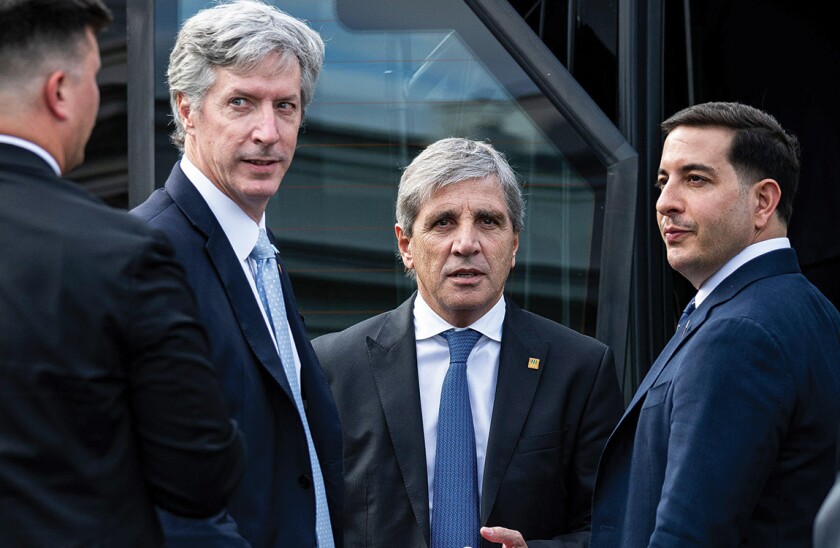Donald Trump’s decision to bail out his Argentinian ally Javier Milei with financial support from the US Treasury has thrown a political cat amongst the fiscal pigeons.
President Milei’s economic team has toured Washington, pitching Argentina’s stabilisation as a success story.
“If we continue on this path, if we continue with our policies,” said finance minister Luis Caputo, “we have our own ‘whatever-it-takes’ from the most powerful country in the world. This is an opportunity we are not going to waste.”
But US support is unlikely to be either bottomless or unconditional.
With Argentina being the International Monetary Fund’s biggest borrower, investors and analysts are asking who is in charge of its fragile economy.
“What is here now is a Frankenstein combination of the Argentine government, the US Treasury and the IMF,” said Branko Maric, a macroeconomic strategist who left US hedge fund Discovery Capital Management earlier this year. “The IMF is losing credibility,” he told GlobalMarkets. “You cannot have programmes for countries where the political driver is the US administration. Do IMF reviews matter? Do IMF targets matter? What’s happening is bizarre at every level.”
Nigel Chalk, deputy director in the IMF’s western hemisphere department and mission chief for the US, told GlobalCapial: “We welcome the support of our partners... including the US.”
The swap line is helping “stabilise” the Argentinian economy, he said, and would “complement the Fund’s programme.
Meanwhile, some hawkish US voices want to replicate the Argentina playbook in Bolivia, where a run-off between two right wing politicians on Sunday will leave the country with its first conservative president for almost two decades.
R Evan Ellis, Latin America research professor at the US Army War College Strategic Studies Institute, argued in an opinion article this week that “whoever wins on October 19th, the US should be prepared to support an aggressive IMF package, and to give a strong signal of US financial support as it did with the Javier Milei regime in Argentina.”
Ellis gave his reasons: “Bolivia could play an important role in the emerging coalition of US-friendly states across the region, and in the push-back against China and organized crime.”
Opaque
Having ostensibly provided a $20bn currency swap line and bought pesos, Treasury secretary Scott Bessent said on Wednesday that the US government was preparing an additional $20bn support package. Multiple media agencies reported Bessent saying this would be a private sector solution, with funding from banks and sovereign wealth funds.
But the details of what the Trump administration is actually providing are frustratingly opaque. “The lack of transparency is incredible,” said Maric.
Hung Tran, a senior fellow at the Atlantic Council’s GeoEconomics Center, said the situation raised questions, including “who is in the driver’s seat?” when it comes to dealing with a crucial IMF borrower, and what the Fund should do.
“Should it [the Fund] change the conditionality to make the programme more socially and politically acceptable to the population? Or should it double down on the current programme?” Tran said.
Caputo and central bank governor Santiago Bausili told an Atlantic Council audience that Argentina was finally on a path to normality, underpinned by Washington’s support and fiscal discipline.
Bausili described the new $20bn swap line as a signal of confidence, not dependence. “Other countries such as Mexico [have] an outstanding swap with the ESF — the Exchange Stabilization Fund,” he said. “The idea is to put in place a more updated version of a facility like that one, [which will be] active within the next two weeks before the mid-terms.”
Argentina’s mid-term elections are scheduled for October 26 and Trump has suggested that US financial help is contingent upon Milei winning.
There is certainly progress worth pointing to. Milei has reduced inflation, turned a budget deficit into surplus and enjoyed economic growth.
Peso pain
But the spectre haunting the halls of Argentina’s treasury is the fragile peso. The Argentine Treasury has spent some $1.5bn since the start of October trying to support it. The currency has fallen 31% against the dollar this year, 24% of that since Argentina made it easier to buy dollars in April.
The central bank has been trying to keep the currency within a band. “It’s been an extraordinarily tough year,” said Vladimir Werning, deputy governor of the Banco Central, on a panel at the Institute of International Finance on Thursday. “The elephant in the room is the mid-term election. Unfortunately in emerging markets when you come from a very short period of high inflation... Argentines hold dollars when they worry about events. If things normalise money demand should come back.”
The central bank hopes that after the election, the peso will bottom out and find a steadier level.
Others believe it is still overvalued. Tran points out that inflation has come down from triple digits to 40%, but despite the steep fall, the currency continues to appreciate on a real terms, trade-weighted basis.
The central bank using precious dollar reserves to support the currency has led to a situation, he said, in which “The overvaluation of the peso has always been the trigger of poor trade performance, poor export performance, current account deficit.”
Argentina is now using US support to help stabilise its currency, but some argue that is just propping up overvaluation.
Much depends on politics — both domestically and in the US. Who knows who will be in power [in the US] 2028?” said Maric. “You can see in the local market that liquidity is all over the place because monetary policy instruments are being determined by the US.”
Lead image: Team Argentina — central bank president Santiago Bausili (left) and minister of the economy Luis Caputo (centre) at the White House in Washington on Tuesday
